With many shops closed due to pandemic restrictions, Black Friday 2020 might have looked different from the frantic buying sprees of years past. But one thing remained the same: the relentless pace of fast fashion. Environmentalists criticised one UK retailer for selling a dress for 8p online.
What are the costs of making garments so cheap? Well, consider an item of clothing we’re all likely to wear at some point – the t-shirt. Like the 8p dress, t-shirts belong to an industry responsible for 10% of global CO? emissions.
Depending on the brand of t-shirt you’re wearing, you could be contributing to these emissions and a long list of other environmental and social harms. But to really understand these impacts, we need to explore the supply chain that creates them.
Spinning a yarn
Most t-shirts are made from cotton, which is grown in 80 countries by 25 million farmers who produced a total of 25.9 million tonnes of fibre between 2018 and 2019. Conventional cotton farming consumes 6% of the world’s pesticides, even though it only uses 2.4% of the world’s land. These chemicals control pests like the pink boll worm, but they can also poison other wildlife and people. Farmers tend to use large amounts of synthetic fertiliser to maximise the amount of cotton they grow, which can degrade soil and pollute rivers.
More than 70% of global cotton production comes from irrigated farms and it takes one-and-a-half Olympic swimming pools of water to grow one tonne of cotton. Your t-shirt could have used 7,000 litres of water just to grow the cotton it’s made from. That’s a lot of water for one t-shirt, especially when you consider that cotton is a crop that tends to be grown in regions plagued by drought. The farmer may have only 10l to 20l of water a day for washing, cleaning and cooking.

Cotton is often grown in parts of the world where water is scarce. Muratart/Shutterstock
But the negative impacts only begin with growing the fibres. The cotton has to be spun into yarn, which uses lots of energy and is the second-highest source of carbon pollution across the t-shirt’s lifecyle, after the dyeing process.
The cotton yarn is then knitted into the fabric that makes the t-shirt. Globally, this process generates an estimated 394 million tonnes of CO? per year.
Finishing touches
Next, colour is added to the fabric. This can be done in many different ways, but all rely on fresh water, which may become contaminated with tiny fibres or chemicals harmful to animals and plants. In some cases, this water is discharged directly into the environment without treatment. In Cambodia for example, where clothing comprises 88% of industrial manufacturing, the fashion industry is responsible for 60% of water pollution.
The dyeing process uses lots of energy to heat the water, as most dye reactions occur at 60°C or higher. The coloured fabric then has to be washed and dried to prepare it for the final stage: garment making. Overall, it takes about 2.6kg of CO? to produce a t-shirt – the equivalent of driving 14km in a standard passenger car.
Transporting the t-shirt to your house accounts for less than 1% of the garment’s total emissions. But once there, it consumes energy, water and chemicals. Washing, ironing and drying clothes represents one-third of the overall climate impact of clothing. Synthetic clothes, made of materials like polyester, generate tiny plastic fibres when washed, which eventually flow into rivers and the sea. Research suggests that synthetic fabrics are responsible for up to 35% of all the microplastics polluting the ocean.
Sadly, the average number of times a garment is worn before being thrown away is falling. In the UK, more than £40 billion (US$53 billion) worth of clothing sits at the back of wardrobes. When emptied, 350,000 tonnes of clothing ends up in landfill each year. Often these garments still have plenty of life in them if they are given the chance – 90% of donated clothes are suitable for racks in UK charity shops. But this relies on consumers saving old clothes from the bin.
Changing clothing
It’s a myth that fast fashion clothing is necessarily poor quality. Many brands do create durable products, some lasting twice as long as designer label equivalents that are up to ten times more expensive.

Donating clothes is a far greener alternative to throwing them out. Omiksovsky/Shutterstock
A growing number of businesses are trying to minimise the environmental impact of their clothes. Some UK brands have begun sourcing cotton which is less reliant on pesticides, synthetic fertilisers and consumes less water. Enough high-quality cotton can be grown to meet current demand with much less water and pesticides.
Cold pad batch dyeing uses up to 50% less water, energy and chemicals than standard processes and produces much less waste. Voluntary initiatives, such as the Sustainable Clothing Action Plan, are trying to set minimum standards for quality across the industry.
You can make a difference too. Buying from responsible brands is a good start, and only washing the garment when it really needs it. Once you’re done with your clothes, giving them to clothing charities offers them a second life and makes fashion overall much greener.
Hopefully knowing more about the vast effort and resources that go into making our clothes can help people make better choices as well. Before throwing old clothes out, remember the long and costly journey your t-shirt took from cotton to wardrobe, and think again.
About the Author
Mark Sumner, Lecturer in Sustainablity, Fashion and Retail, University of Leeds
This article is republished from The Conversation under a Creative Commons license. Read the original article.
Related Books
Life After Carbon: The Next Global Transformation of Cities
by Peter Plastrik , John Cleveland The future of our cities is not what it used to be. The modern-city model that took hold globally in the twentieth century has outlived its usefulness. It cannot solve the problems it helped to create—especially global warming. Fortunately, a new model for urban development is emerging in cities to aggressively tackle the realities of climate change. It transforms the way cities design and use physical space, generate economic wealth, consume and dispose of resources, exploit and sustain the natural ecosystems, and prepare for the future. Available On Amazon
The future of our cities is not what it used to be. The modern-city model that took hold globally in the twentieth century has outlived its usefulness. It cannot solve the problems it helped to create—especially global warming. Fortunately, a new model for urban development is emerging in cities to aggressively tackle the realities of climate change. It transforms the way cities design and use physical space, generate economic wealth, consume and dispose of resources, exploit and sustain the natural ecosystems, and prepare for the future. Available On Amazon
The Sixth Extinction: An Unnatural History
by Elizabeth Kolbert Over the last half-billion years, there have been Five mass extinctions, when the diversity of life on earth suddenly and dramatically contracted. Scientists around the world are currently monitoring the sixth extinction, predicted to be the most devastating extinction event since the asteroid impact that wiped out the dinosaurs. This time around, the cataclysm is us. In prose that is at once frank, entertaining, and deeply informed, New Yorker writer Elizabeth Kolbert tells us why and how human beings have altered life on the planet in a way no species has before. Interweaving research in half a dozen disciplines, descriptions of the fascinating species that have already been lost, and the history of extinction as a concept, Kolbert provides a moving and comprehensive account of the disappearances occurring before our very eyes. She shows that the sixth extinction is likely to be mankind's most lasting legacy, compelling us to rethink the fundamental question of what it means to be human. Available On Amazon
Over the last half-billion years, there have been Five mass extinctions, when the diversity of life on earth suddenly and dramatically contracted. Scientists around the world are currently monitoring the sixth extinction, predicted to be the most devastating extinction event since the asteroid impact that wiped out the dinosaurs. This time around, the cataclysm is us. In prose that is at once frank, entertaining, and deeply informed, New Yorker writer Elizabeth Kolbert tells us why and how human beings have altered life on the planet in a way no species has before. Interweaving research in half a dozen disciplines, descriptions of the fascinating species that have already been lost, and the history of extinction as a concept, Kolbert provides a moving and comprehensive account of the disappearances occurring before our very eyes. She shows that the sixth extinction is likely to be mankind's most lasting legacy, compelling us to rethink the fundamental question of what it means to be human. Available On Amazon
Climate Wars: The Fight for Survival as the World Overheats
by Gwynne Dyer Waves of climate refugees. Dozens of failed states. All-out war. From one of the world’s great geopolitical analysts comes a terrifying glimpse of the strategic realities of the near future, when climate change drives the world’s powers towards the cut-throat politics of survival. Prescient and unflinching, Climate Wars will be one of the most important books of the coming years. Read it and find out what we’re heading for. Available On Amazon
Waves of climate refugees. Dozens of failed states. All-out war. From one of the world’s great geopolitical analysts comes a terrifying glimpse of the strategic realities of the near future, when climate change drives the world’s powers towards the cut-throat politics of survival. Prescient and unflinching, Climate Wars will be one of the most important books of the coming years. Read it and find out what we’re heading for. Available On Amazon
From The Publisher:
Purchases on Amazon go to defray the cost of bringing you InnerSelf.comelf.com, MightyNatural.com, and ClimateImpactNews.com at no cost and without advertisers that track your browsing habits. Even if you click on a link but don't buy these selected products, anything else you buy in that same visit on Amazon pays us a small commission. There is no additional cost to you, so please contribute to the effort. You can also use this link to use to Amazon at any time so you can help support our efforts.

























